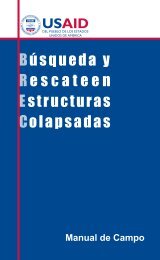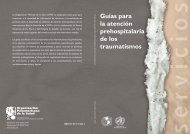Humanitarian Supply Management and Logistics in the Health Sector
Humanitarian Supply Management and Logistics in the Health Sector
Humanitarian Supply Management and Logistics in the Health Sector
Create successful ePaper yourself
Turn your PDF publications into a flip-book with our unique Google optimized e-Paper software.
Preparedness<br />
After <strong>the</strong>se questions have been answered satisfactorily, we must draw<br />
up a list of preparatory activities. The more time <strong>and</strong> effort we <strong>in</strong>vest <strong>in</strong><br />
such activities, <strong>the</strong> greater <strong>the</strong> return <strong>in</strong> terms of our knowledge of <strong>the</strong><br />
<strong>the</strong>ater of operations, our weaknesses <strong>and</strong> those of our partners, eventual<br />
needs, <strong>and</strong> alternative solutions depend<strong>in</strong>g on different scenarios.<br />
These activities, which are described below, can be broken down by<br />
national regions, depend<strong>in</strong>g on <strong>the</strong> size of <strong>the</strong> country, beg<strong>in</strong>n<strong>in</strong>g with<br />
those areas most at risk from natural disasters. Alternatively, organizations<br />
may decide on which geographical areas <strong>the</strong>y will focus <strong>the</strong>ir<br />
attention.<br />
Preparedness must also be based on <strong>the</strong> vulnerability <strong>and</strong> resource<br />
assessments normally carried out to develop a national or regional<br />
emergency response plan. We must never forget that logistics has to be<br />
a key component of any such plan.<br />
Preparatory activities must <strong>in</strong>clude <strong>the</strong> follow<strong>in</strong>g:<br />
Chapter 2: <strong>Logistics</strong> 11<br />
◆ Assess<strong>in</strong>g <strong>the</strong> vulnerability of key <strong>in</strong>frastructure—The goal is to identify<br />
<strong>the</strong> strengths <strong>and</strong> weaknesses of public works <strong>and</strong> strategic<br />
structures of <strong>the</strong> country or region—highways, water supply systems,<br />
schools, hospitals—as well as alternative actions that may be<br />
required should <strong>the</strong> <strong>in</strong>frastructure collapse. Specific actions would<br />
<strong>in</strong>clude:<br />
▲ Systematically mapp<strong>in</strong>g <strong>and</strong> evaluat<strong>in</strong>g national transport<br />
<strong>in</strong>frastructure (ports, airports, highways, railroads, <strong>and</strong> waterways),<br />
tak<strong>in</strong>g <strong>in</strong>to account <strong>the</strong> capacity <strong>and</strong> potential weaknesses<br />
of strategic routes, possible bottlenecks (bridges, ferries),<br />
availability of communication resources, <strong>and</strong> risks to <strong>the</strong> <strong>in</strong>frastructure<br />
<strong>in</strong> <strong>the</strong> event of an emergency. It is essential to determ<strong>in</strong>e<br />
<strong>the</strong> vulnerability of ports <strong>and</strong> airports to natural disasters.<br />
We must consider, for <strong>in</strong>stance, <strong>the</strong> exposure of hangars <strong>and</strong><br />
warehouses, or load<strong>in</strong>g <strong>and</strong> fuel<strong>in</strong>g equipment, to <strong>the</strong> impact of<br />
a hurricane or an earthquake;<br />
▲ Analyz<strong>in</strong>g <strong>the</strong> historical meteorological records of <strong>the</strong> country<br />
or region to determ<strong>in</strong>e <strong>the</strong> impact that severe wea<strong>the</strong>r might<br />
have on <strong>the</strong> capacity of <strong>the</strong> transport system at different times<br />
of <strong>the</strong> year;






